
When the first website went live on August 6, 1991, no one knew how big the internet would become. What was once a novel technology has morphed into an integral part of our lives, changing the way we work, learn, and socialize. Today, the internet is home to almost two billion websites, all hosted by a physical server or somewhere in the cloud.
In this article, I’ll talk about how much the web hosting industry has grown and who the key players in this industry are. I’ll also throw in some quick facts about web hosting services’ market share in 2024. Let’s get started!
1. Amazon Web Services (18%), Google Cloud (8%), and GoDaddy (8%) Hold the Biggest Market Share
The top hosting providers are AWS, Google Cloud, and GoDaddy, holding an 18%, 8%, and 8% market share respectively1.
GoDaddy is the undisputed king of website hosting services. This host boasts many titles under its belt, most notably for being the world’s largest domain registrar 2. The company comprises more than 6,000 employees, at least 20 million customers, 84 million registered domains, and 14 offices in the United States, Asia, and Europe1.
AWS (Amazon Web Services) rules the cloud hosting sphere. For context, NASA, Quora, Reddit, Netflix, Twitch, Facebook, the BBC, Adobe, Twitter, and ESPN are examples of top companies that host their sites on AWS 3. Today, AWS backs more than 2,000 government agencies and at least 5,000 academic institutions and is available in more than 12 geographical locations across the globe4.
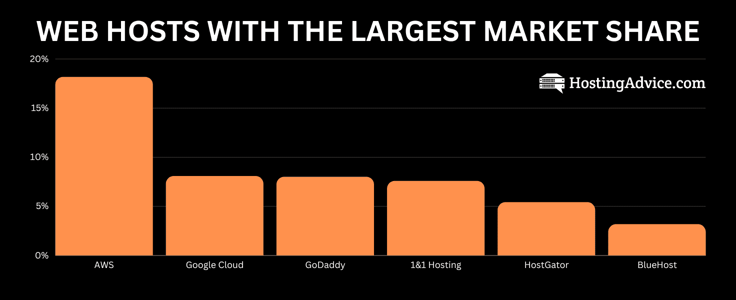
Google Cloud Platform is a cloud hosting provider similar to AWS. This cloud hosting platform is one of the biggest contributors to Google’s financial prowess. In 2022, for example, GCP generated more than $26 billion, representing 9% of Google’s total revenue that year 5. Companies like PayPal, Home Depot, Etsy, and the United States Postal Service host their websites and applications on the platform.
2. The Web Hosting Industry Is Worth $94.64 Billion
In 1969, at the height of the Cold War, the first web host came to birth. Named ARPANET and commissioned at the University of California in Los Angeles (UCLA), it mostly helped with academic research 6. Decades later, the web hosting industry has grown tremendously.
In 2022, the web hosting industry in the United States was worth $94.64 billion. Two years earlier, the value stood at around $75 billion. By the end of 2023, experts predict that this industry will be worth more than $124 billion 7.
3. The Hosting Industry Is Expected to Grow 18% by the Year 2028
The hosting industry has been on an upward trajectory thanks to the emergence of new technologies mostly dependent on the internet. As more people spend their time online, hosting companies continue to reap billions of dollars by hosting applications and websites. In fact, at the beginning of 2022, at least 5.1 billion people used the internet for socializing, entertainment, and shopping 8.
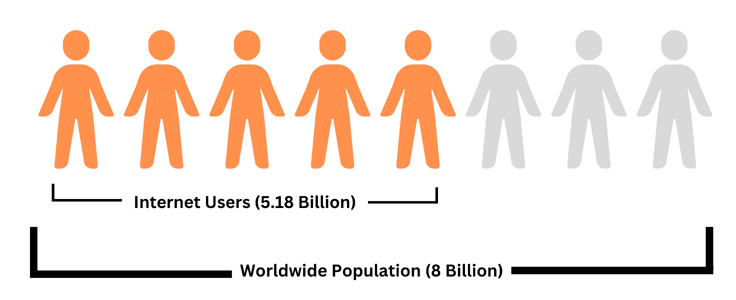
Analysts predict an 18% growth by 2028. One report showed that in 2028, this industry will be worth more than $267 billion 9. Another report projected a $392 billion growth by 2030 10.
4. Shared Hosting Makes Up 10.3% of the Market
Shared Hosting is still the most affordable option, making it popular in the market as well. In a shared server environment, multiple websites are hosted on the same physical machine. These sites share resources such as storage and bandwidth.
This affordable option currently makes up 10.3% of the hosting market12. Despite its low price, shared hosting rakes in an impressive amount of revenue. Its popularity with new website owners continues to compete with cloud hosting.
5. Cloud Hosting is Expected to Grow 18.3% Per Year Through 2025
Cloud hosting has steadily risen after the COVID-19 pandemic. As more people begin to realize the benefits of working remotely, and as web hosting continues to shift from traditional bare-metal infrastructure to cloud servers, cloud hosting continues to grow.
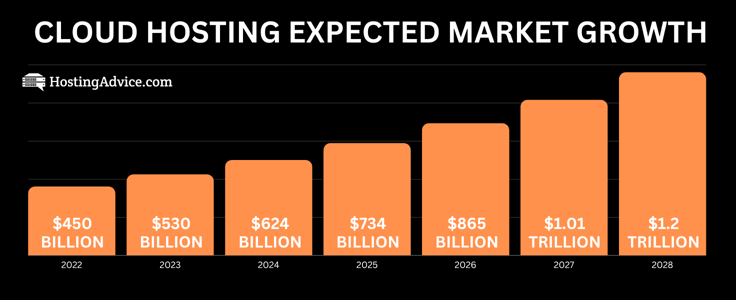
For perspective, one report revealed that the cloud computing market could be worth more than $1.2 trillion by 2028 11.
6. Dedicated Hosting Makes Up 5.6% of the Market
Dedicated hosting makes up the smallest fraction of the market share at 5.6%14. Many question whether dedicated servers are still relevant with the boom in cloud hosting. However, they’re a reliable choice for businesses wanting security and control of their server environment.
Dedicated servers are the most expensive option because customers get an entire server’s resources. This differs significantly from the pay-as-you-go pricing structure of the cloud. With the growth of cloud hosting, dedicated servers are decreasing in popularity, but they are far from being retired.
7. GoDaddy Is the Largest Domain Registrar, Holding 84 Million Domains
It comes as no surprise that GoDaddy is the world’s largest domain name registrar. What else would you expect from a web hosting company with more than 84 million registered domains and 21 million customers15?

And if web hosting statistics are anything to go by, GoDaddy has the domain registrar industry in a chokehold. The company offers more than 530 domain name extensions, with new choices being added regularly16.
8. NameCheap Is the Second Largest Domain Registrar, Holding 17 Million Domains
NameCheap is the second largest domain registrar in the world, registering an impressive 17 million domain names17. This registrar and web host is well-known for its website tools for site owners and designers, including its Logo Maker.
Although NameCheap may have a lot of catching up to compete with GoDaddy, its growth in recent years has built a strong reputation in the industry. It offers a range of tools and features, including WordPress hosting, domain name registration, and bundles of social and visual apps.
9. There are 330,000 Web Hosting Companies Worldwide
In 1969, only about four web hosting companies existed. Today, there are more than 330,000 hosting providers across the globe 18. The United States is home to more than 50% of these companies, followed closely by Germany, the United Kingdom, and France.
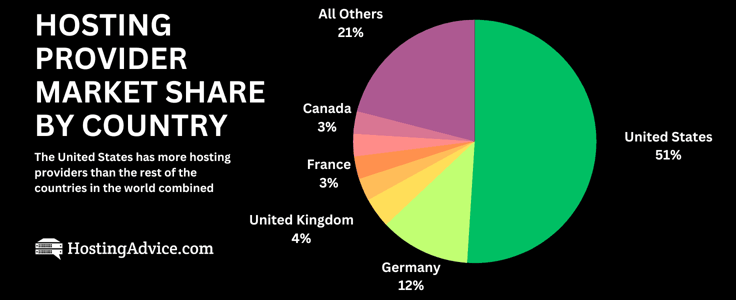
The numbers aside, the United States is also home to some of the biggest and most powerful web hosting service providers. The country boasts a heavy lineup comprising the three largest web hosting providers: GoDaddy, Amazon Web Services, and Google Cloud Platform.
Other popular web hosts in the country include Bluehost (best for WordPress hosting), HostGator, Rackspace, Media Temple, Digital Ocean, Newfold Digital, Liquid Web, InMotion Hosting, and Dream Host.
10. There are 1.98 Billion Websites Online
The internet is home to more than 1.98 billion websites 19. And this number is constantly growing. With folks making roughly 250,000 websites daily, that’s a new website every three seconds. It’s no wonder the web hosting industry is booming.
The sheer number of websites online is something other-worldly. It’s physically impossible to visit even a fraction of the world’s websites in a lifetime. However, most websites are not actively used. In fact, only 200 million of these websites are active. The rest are sitting on the digital shelf, collecting pixel dust.
11. The United States Has the Most (2,700) Datacenters
The United States controls the global datacenter market. To begin with, there are more than 8,000 datacenter locations across the world20. Out of the 8,000, at least 2,700 reside in the United States.
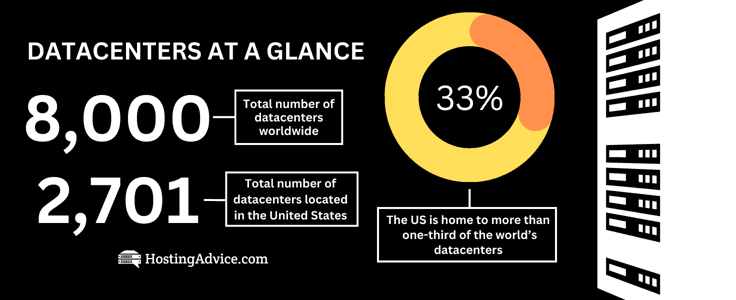
Germany comes second with 487, the United Kingdom comes third with 456, China takes the 4th spot with 443, and Canada seals the top five spot with 328.
According to a new report, the global datacenter market will grow at an annual rate of 6.5% from 2021 to 2027 21. And by 2030, the global datacenter colocation market will be worth at least $131 billion 22.
Final Thoughts on Web Hosting Market Share and Growth
The future of web hosting is bright if numbers are anything to go by. And now that the world is witnessing inventions that depend mainly on the internet, this industry will continue growing yearly.
Based on the data above, we predict a future where cloud hosting remains the most popular hosting solution, given that it is more scalable, safer, and agile than traditional bare-metal hosting infrastructure.
So, where does this put you as a consumer? The influx of new hosting providers is healthy from a consumer’s perspective. In the coming years, we will witness more affordable hosting options as providers compete to have a firm grip on the market share.
It’s also likely that GoDaddy will maintain its dominance in the domain industry, given that it has moved most of its infrastructure to AWS, primarily to take advantage of cloud hosting solutions23.
Whichever way you look at it, you will realize that although so much has changed over the past few years in the world of technology, the growth of the web hosting industry has stayed constant.
Sources and Further Reading
- https://www.datanyze.com/market-share/web-hosting–22/
- https://aboutus.godaddy.net/about-us/overview/default.aspx
- https://www.yahoo.com/video/15-biggest-companies-aws-011011152.html
- https://www.simplilearn.com/tutorials/aws-tutorial/what-is-aws
- https://www.statista.com/statistics/478176/google-public-cloud-revenue
- https://100.ucla.edu/timeline/the-internets-first-message-sent-from-ucla
- https://www.statista.com/outlook/tmo/it-services/it-outsourcing/web-hosting/worldwide#revenue
- https://www.statista.com/statistics/617136/digital-population-worldwide/
- https://www.wpbeginner.com/research/ultimate-web-hosting-statistics-and-market-share-report
- https://www.databridgemarketresearch.com/reports/global-web-hosting-services-market
- https://www.globenewswire.com/en/news-release/2023/04/27/2655933/0/en/Riding-the-Digital-Wave-Can-the-Global-Cloud-Computing-Markets-Astounding-Growth-reach-a-whopping-1-2-Trillion-by-2028-Ken-Research.html
- https://www.businesswire.com/news/home/20221104005409/en/Web-Hosting-Services-Global-Market-Report-2022-Green-Web-Hosting-Gains-Traction-and-Presents-Opportunities—ResearchAndMarkets.com
- https://techjury.net/blog/web-hosting-industry-statistics
- https://financesonline.com/30-essential-web-hosting-statistics-2019-analysis-of-trends-data-and-market-share/
- https://whoapi.com/blog/largest-domain-registrars-in-the-world/
- https://www.godaddy.com/en-ph/domains/gtld-domain-names
- https://www.namecheap.com/guru-guides/domain-insights-trends-report-2023/
- https://webtribunal.net/blog/web-hosting-statistics/#gref
- https://firstsiteguide.com/how-many-websites/
- https://www.usitc.gov/publications/332/executive_briefings/ebot_data_centers_around_the_world.pdf
- https://www.prnewswire.com/news-releases/global-data-center-colocation-market-report-2023-2027-featuring-major-operators—equinix-digital-realty-cyrusone-stack-infrastructure-qts-realty-trust-st-telemedia-global-data-centres-301739231.html
- https://techblog.comsoc.org/2022/10/30/global-data-center-colocation-market-size-forecast-131-8-billion-by-2030-at-a-14-2-cagr/
- https://www.godaddy.com/engineering/2021/05/07/godaddys-journey-to-the-cloud/







